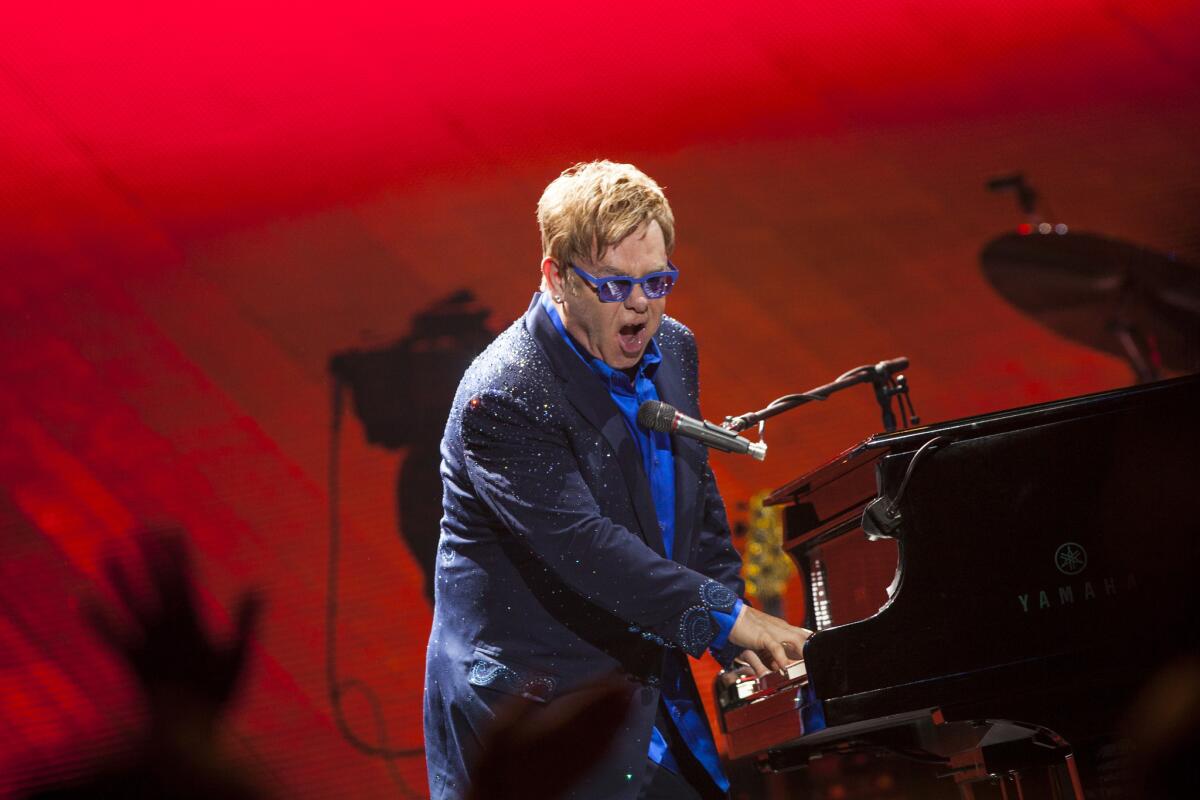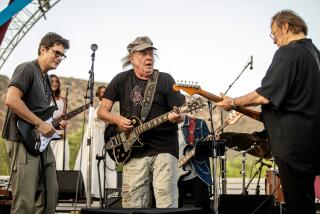Review: Elton John at Staples Center: An icon with endurance on his mind

He’s still standing — or at least he was Saturday night at Staples Center.
That’s where Elton John, playing the first of two weekend concerts on his so-called All the Hits tour, leaped to his feet from behind a grand piano after nearly every song in a 2½-hour set. Sometimes he did it to stoke the capacity crowd’s applause, his arms outstretched like a champion’s; at one point he did it to get close enough to sign autographs for fans in the front row. Whatever the particulars at any given moment, the physical display was emphasizing a single idea: that this pop icon, now 67, hasn’t yet run out of steam.
In that way, John’s current live show is closely aligned with large-scale traveling productions by Paul McCartney and Bruce Springsteen. You go see these Rock and Roll Hall of Famers in the arenas and stadiums they still fill and you come away thinking about endurance — of voices and bodies but also of careers and, to use a term these guys certainly didn’t back in the old days, of brands. You consider what it takes to sell expensive T-shirts to people who’ve already paid for expensive concert tickets. And you think about meaning, specifically how much of it these artists continue to find (or not) in their most familiar work.
The Elton John brand — splashy, dramatic, nakedly sentimental but more than a little cheeky — was operating at full strength Saturday, even as the show went largely without the kind of visual spectacle he once brought to the stage. Instead of his famous bedazzled Dodgers uniform, for instance, he wore merely a bedazzled suit jacket. But all it took to set the audience roaring was the first chord of “Bennie and the Jets”; later, the blue-jean babies and L.A. ladies in the house cheered even louder at the opening tinkles of “Tiny Dancer.”
Throughout the gig — which complemented the promised hits with a few relative obscurities such as “Holiday Inn,” as well as two cuts from the singer’s stripped-down 2013 album “The Diving Board” — John sang powerfully, reaching down into a bluesy baritone where he might in the past have reached up into an airy falsetto. A concession to age? Of course. Often, though, the new colors increased the beauty of the music, as in “Rocket Man,” which here sounded like a torch song from the edge of the world.
His piano playing exhibited no such decay as he peeled off florid solos in “Levon” and “Don’t Let the Sun Go Down on Me”; indeed, the show began with “Funeral for a Friend,” the elaborate instrumental fanfare that opens the 1973 smash album “Goodbye Yellow Brick Road.” To fully show off his virtuosity, close-up shots of John’s fingers on the keyboard flickered on the video screens flanking the stage.
Yet as he muscled through these songs — reliably backed by a five-piece band that featured his original drummer, Nigel Olsson, and his guitarist since the early ’70s, Davey Johnstone — John didn’t always give the impression of someone connecting with the music, minute to minute.
The ballads, especially, seemed to be tracing old lines. “Candle in the Wind,” “Your Song,” the title track from “Goodbye Yellow Brick Road” — in each, John doled out the well-worn emotion as smoothly (and impassively) as the video sequence that depicted milestones in his life, including his reputation-making stint at the Troubadour in 1970 and his success on Broadway with “Aida” and “The Lion King.” The words appeared not to be speaking to him anymore.
Does it matter that, unlike McCartney or Springsteen — or Billy Joel, with whom he’s toured — John didn’t write those words? As the singer took care to explain at Staples Center before he performed “Your Song,” he composes melodies to lyrics provided by his longtime collaborator Bernie Taupin, who John said was present at Saturday’s show, just as the lyricist had been at the Troubadour 44 years ago.
I’m inclined to think not. Pop is as much an interpreter’s medium as a songwriter’s — and, besides, anyone who’s seen McCartney or Springsteen knows that those two can coast at altitude as well. (Joel may be another story, based on his thrilling appearance this year at the Hollywood Bowl, where he crammed his classic tunes with loads of fresh acrimony.)
What’s more, the distance John has from his songs could be precisely why he’s historically brought so much character to them — and did again Saturday in electrifying renditions of “The Bitch Is Back” and “I’m Still Standing” and a stark take on “The Diving Board” track “Oceans Away,” before which he spoke movingly about the brutality of the first World War. Denied access to the reassuring fantasy that a singer is drawing from his real life (whatever that means), John relies on what he’s actually projecting in real time.
Except for when he doesn’t.
In the weakest parts of Saturday’s show, infrequent but significant, the singer relied not on his performance but on our memories of his songs to do the heavy lifting for him. That’s a sign of endurance too, as he helped make those memories. But nostalgia is awfully thin vapor for a machine used to running on more.
Twitter: @mikaelwood
More to Read
The biggest entertainment stories
Get our big stories about Hollywood, film, television, music, arts, culture and more right in your inbox as soon as they publish.
You may occasionally receive promotional content from the Los Angeles Times.











